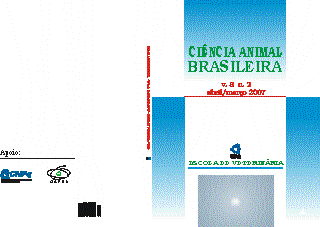EVALUATION OF FOETAL DEVELOPMENT IN SANTA INÊS SHEEP USING ULTRA-SOUND
Keywords:
Ovinos, reprodução, gestaçãoAbstract
Thirty two Santa Inês ewes were synchronized and bred, resulting in 18 pregnancies. These were use to inves-tigate the reliability of developmental parameters in the estimation of gestational age. The ultra-sound evaluations were carried out from day 8 to 55 of pregnancy, with day zero being the first day of breeding. For positive pregnancy diagnosis the visualization of the fetus and heart beat were considered. Gestational age was determined using: cranial-caudal length (CCC), biparietal diameter (DBP), thoracic diameter (DT), and measurements of the gestational sac. All parameters had a positive correlation with gestational age, especially DBP which was more reliable and easier to measure. In addition, growth equations were calculated to determine gestational age from the measurements. In terms of methods of carrying out the ecograph, the trans-rectal route was more practical up to 45 days after service. After this the transabdominal route was seen to be more adequate.
KEY-WORDS: Age, ewe, fetal measuring, gestational.
Downloads
Downloads
Published
How to Cite
Issue
Section
License
Copyright (c) 2007 Brazilian Animal Science/ Ciência Animal Brasileira

This work is licensed under a Creative Commons Attribution 4.0 International License.
Authors who publish with this journal agree to the following terms:
- Authors retain copyright and grant the journal right of first publication with the work simultaneously licensed under a Creative Commons Attribution License that allows others to share the work with an acknowledgement of the work's authorship and initial publication in this journal.
- Authors are able to enter into separate, additional contractual arrangements for the non-exclusive distribution of the journal's published version of the work (e.g., post it to an institutional repository or publish it in a book), with an acknowledgement of its initial publication in this journal.
- Authors are permitted and encouraged to post their work online (e.g. in institutional repositories or on their website) prior to and during the submission process, as it can lead to productive exchanges, as well as earlier and greater citation of published work (See The Effect of Open Access).




























